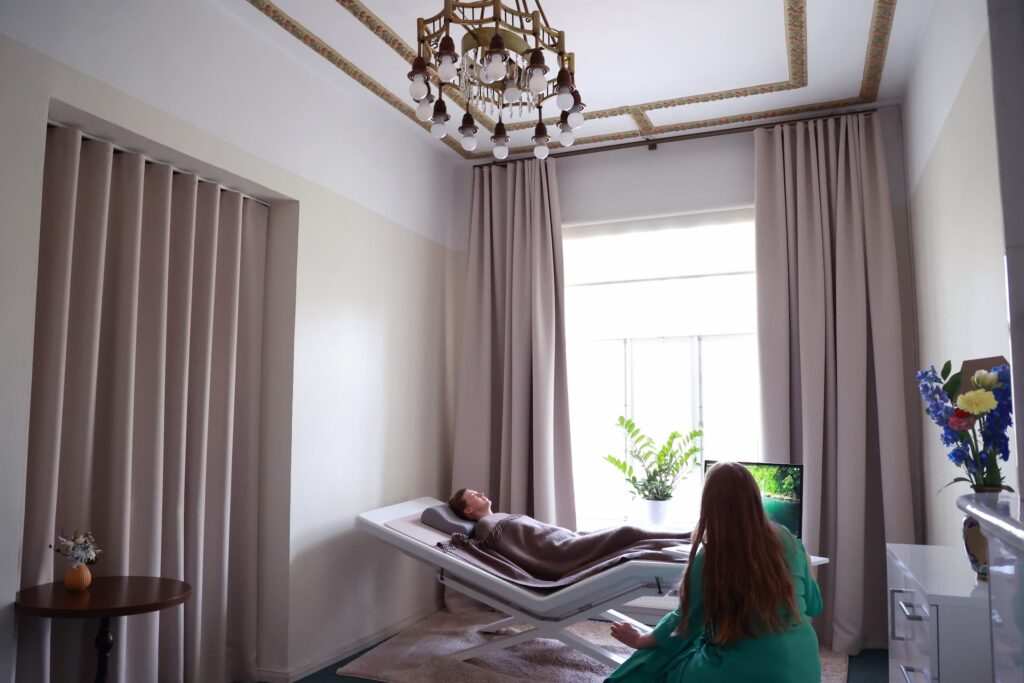
Vibroacoustic therapy
Vibroacoustic (VA) therapy is a treatment method that uses low-frequency pulsating sinusoidal sounds in the range from 30 Hz to 120 Hz in combination with music.
During the procedure, the patient lies on a bed with built-in speakers. Low-frequency sound vibrations are transmitted, which a person can subjectively perceive as a massage. In the background, specially selected music is playing, which helps to mask the noise and to relax.
VA therapy, originally developed as a receptive music therapy, is currently used by many healthcare professionals, and finds application in several fields. Depending on the preparation of the person performing the procedure, a therapeutic aspect can be added to the physical effect, which allows you to get a holistic experience for the body and mind.

Where can vibroacoustic therapy help?
- relief of stress-related symptoms (tension, anxiety, sleep problems, etc.)
- improvement of relaxation skills
- reduction of pain (incl. menstrual pain, fibromyalgia)
- relief of muscle tension and spasms
- relief of neurological symptoms (e.g., tics)
- reduction of high blood pressure
- relief of difficulty breathing
- in case of psychological disorders (e.g., anxiety, depression, eating disorders)
- improvement of body awareness
Duration and intensity of the course of treatment
Treatment is carried out considering the indications and individual needs.
Usually 10-15 sessions are performed, but long-term therapy (for example, 40 sessions) and interval therapy (for example, 2-4 sessions per year) are also possible.
In the case of a sequential course, it is usually recommended to conduct 2-3 sessions a week or at least once a week. In some cases, treatment can also be carried out 2 times a day.
Session structure
- Discussion before treatment (a longer conversation at the first meeting – the suitability of the method, goals, if necessary, some evaluating tests)
- Vibroacoustic therapy. Usually the procedure lasts 20-30 minutes and is used either with or without a musical background, supported by a discussion if needed.
- Discussion after treatment – client feedback, therapist recommendations. Sometimes, especially when working with children, it is combined with other methods of creative therapy, including drawing or playing music.
- Assessment of the therapeutic effect, preparation of a treatment plan at the first appointment, if necessary, answering an evaluation questionnaire.
Possible contraindications
In case of contraindications, you should consult a doctor and a VA specialist in advance. In case of high risk conditions, it is necessary to assess the potential benefits versus harm from the procedure.
- Acute diseases; for example, thrombus, angina pectoris, systolic blood pressure higher than 200 mm Hg.
- Inflammatory process in the body (primarily acute and active inflammation)
- Dislocation of an intervertebral disc
- Neck and head injuries (in the last 6 months)
- Acute bleeding (except menstruation)
- Psychotic disorders, increased vulnerability, and risk of psychotic state
- Recent heart attack, cardiac arrhythmia
- Pacemaker
- Autoimmune disease lupus
- Stones or sand in the kidneys or bladder
- Pregnancy
SERVICES
Vibroacoustic therapy (up to 60 min)
- Discussion before treatment (a longer conversation at the first meeting – the suitability of the method, goals, if necessary, some evaluating tests)
- Vibroacoustic therapy. Usually the procedure lasts 20-30 minutes and is used either with or without a musical background, supported by a discussion if needed.
- Discussion after treatment – customer feedback, therapist recommendations.
- Assessment of the therapeutic effect, preparation of a treatment plan at the first appointment, if necessary, answering an evaluation questionnaire.
Vibroacoustic therapy, repeated admission (up to 30 min.)
- Discussion before treatment (condition mapping).
- Vibroacoustic therapy. Usually the procedure lasts 20-30 minutes and is used either with or without a musical background, supported by a discussion if needed.
- Assessment of the therapeutic effect, preparation of a treatment plan at the first appointment, if necessary, answering an evaluation questionnaire.